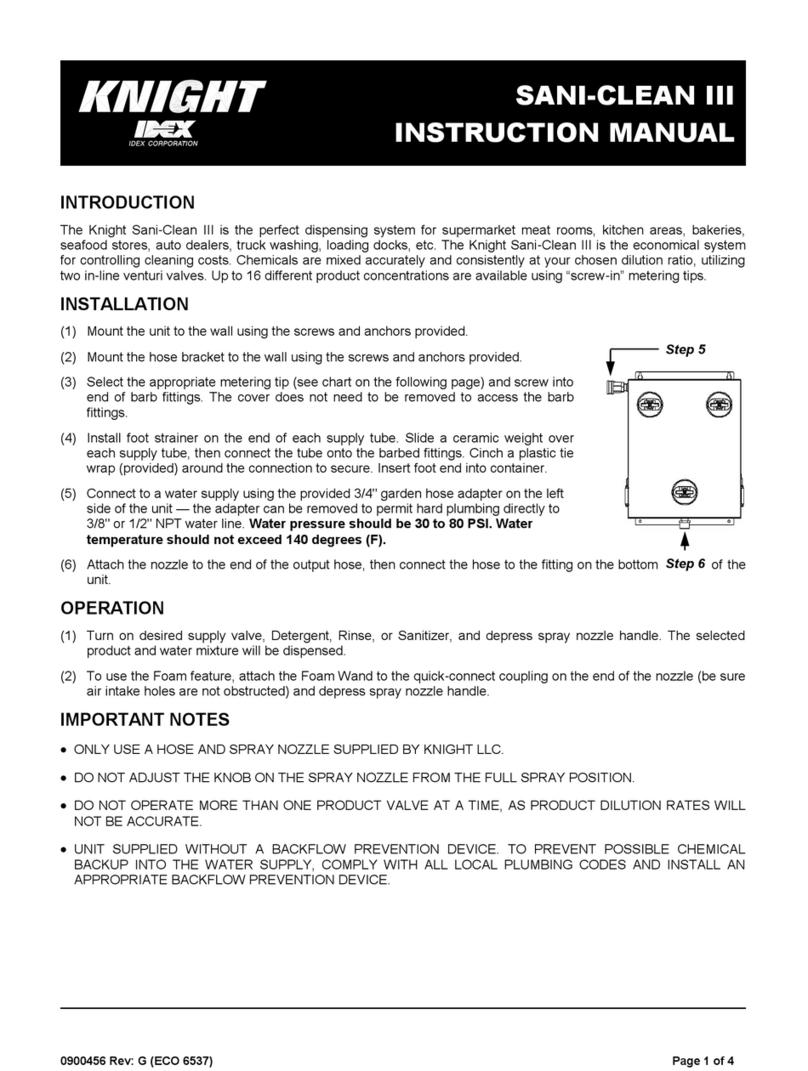
0900591 Rev: A (07/04) Page 5 of 24
INSTALLATION — ELECTRICAL
Review the wiring diagrams on pages 20 - 22 to
familiarize yourself with the wiring connections that
apply to the UniTech model you have.
Important note for pre-wired units: These models have
color coded wires for power, signals, and probe. Be sure
to use the correct wires for the following electrical
connections. The transformer connections in these
models are pre-wired for 230V (as shown in the wiring
diagrams). This must be changed inside the unit
prior to installation for 115V or 208V applications!
European models will always be 230V only!
Make sure that all power is off to the dishmachine. Open
the cover and locate an appropriate source for the wash
pump and rinse pump signals, plus a main power
source (for single transformer units). Consult the wiring
diagram for the dishmachine, if available.
Main Power
A main power connection only applies to single
transformer systems (typical). Disregard this section for
dual transformer systems.
Connect leads to a 115, 208, or 230 VAC power source
that is “on” when the dishmachine is “on.” This will
provide power for both detergent and rinse however,
UniTech will only pump chemical when electrically
signaled. Whenever possible, use the dishmachine’s
ON/OFF switch as the main power source. Avoid using
the dishmachine’s washpump motor as main power.
Detergent Signal
A detergent signal is required to either activate the
detergent probe sensing operation, or to trigger
probeless initial charge. A detergent signal is not
normally required when using probeless/door mode, as
the rinse signal is typically used to trigger initial charge.
Check the dishwasher for a power source that is active
during the wash cycle only, for example, the magnetic
contactor that controls the wash pump motor.
•Single transformer: Connect leads to the detergent
signal source. Signal voltage range is 14 - 240 VAC.
•Dual transformer: Connect leads to the detergent
power source (must be 115, 208, or 230 VAC).
Rinse Signal
In addition to running the rinse pump, the rinse power
signal triggers detergent recharge injection if probeless
mode is selected. The rinse signal can also be used to
trigger the detergent initial charge if using probeless/
door mode.
Check the dishwasher for a power source that is active
during the rinse cycle only, for example, the rinse
solenoid or rinse cycle light.
•Single transformer: Connect leads to the rinse signal
source. Signal voltage range is 14 - 240 VAC.
•Dual transformer: Connect leads to the rinse power
source (must be 115, 208, or 230 VAC).
Probe Installation (if required)
Drain the dishmachine if necessary. Install the probe per
the following steps, or replace any existing probe (if
there is one). Use new probe wire in either case.
(1) Install the probe in the wash tank below the water
level. It should be away from incoming water
supplies, near the recirculating pump intake, and 3
to 4 inches from corners, heating elements, or the
bottom of the tank. If an existing mounting hole
cannot be located, cut or punch a 7/8" hole.
(2) Use 18 AWG multi-stranded copper wire for the
probe connection. Avoid running the wire near high
voltage AC lines. Do not route probe wires through
the same conduit as power and signals.
(3) Connect leads to the probe. Ring-type terminals are
recommended (be sure to connect them to the
probe terminals with “backing” nuts to prevent the
probe tips from being pulled out of the probe). The
ring terminals should be secured between the inner
(backing) nuts and outer nuts.





























